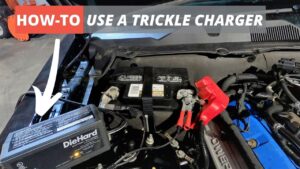Can you start a car with a battery charger connected? The short answer is yes, you can! Imagine the scenario: you hop into your car, turn the key, and nothing happens. Panic sets in as you realize your battery is dead, and you’re in a rush to get to your destination. But fear not, because there might be a simple solution. By connecting a battery charger to your car’s battery, you could potentially get it up and running again without having to wait for a jump-start or call for roadside assistance. So, let’s dive into the details and find out how this process works.
Can You Start A Car With A Battery Charger Connected
Have you ever found yourself in a situation where your car battery has died, and you’re left stranded with no way to start it? It can be a frustrating and inconvenient experience, to say the least. Thankfully, there’s a solution that many people turn to in these moments of despair – a battery charger. But can you start a car with a battery charger connected? In this article, we’ll delve into this topic to provide you with all the information you need to know.
The Basics of Battery Chargers
Before we explore whether you can start a car with a battery charger connected, let’s first understand the basics of battery chargers. A battery charger is a device designed to recharge a dead or depleted car battery. It works by supplying electrical currents to the battery, helping it regain its charge and providing the necessary power to start the car.
Most battery chargers come with various features and settings to cater to different types of batteries, including lead-acid batteries, gel batteries, and AGM batteries. These chargers are typically equipped with safety measures to protect against overcharging and polarity reversal, ensuring the battery is charged safely and efficiently.
Connecting a Battery Charger
Now that we have a basic understanding of battery chargers, let’s focus on connecting one to a car battery. When connecting a battery charger, it is essential to follow the manufacturer’s instructions carefully. However, here are the general steps to follow:
- Make sure both the battery charger and the car engine are turned off.
- Locate the positive and negative terminals on the car battery. The positive terminal is usually marked with a “+” sign or the letters “POS,” while the negative terminal is marked with a “-” sign or the letters “NEG.”
- Identify the corresponding positive and negative clamps on the battery charger. The positive clamp is typically red, while the negative clamp is black.
- Attach the positive clamp of the battery charger to the positive terminal of the car battery. Ensure a secure connection.
- Attach the negative clamp of the battery charger to a metal part of the car’s chassis, away from the battery. This step is important to prevent any sparks near the battery.
Charging Your Car Battery
Once you have successfully connected the battery charger to the car battery, it’s time to charge the battery. Follow these steps:
- Refer to the manufacturer’s instructions to select the appropriate charging mode and settings for your battery type.
- Turn on the battery charger and set the desired charging parameters.
- Allow the battery charger to charge the car battery for the recommended amount of time. This duration can vary depending on the battery’s condition and the charger’s specifications.
- Monitor the charging progress using the indicators provided on the charger. These indicators may include lights, gauges, or digital displays.
- Once the battery is fully charged, turn off the charger and disconnect the clamps from the car battery, starting with the negative clamp first.
Can You Start a Car With a Battery Charger Connected?
Now, let’s answer the burning question: Can you start a car with a battery charger connected? The answer is both yes and no, depending on the type of battery charger you are using.
Traditional Battery Chargers
If you are using a traditional battery charger, commonly known as a manual or non-automatic charger, you cannot start a car with the charger connected. These chargers require you to disconnect them from the battery before attempting to start the car. Failing to disconnect the charger can result in damage to both the charger and the vehicle’s electrical system.
Smart Battery Chargers
On the other hand, if you are using a smart battery charger, also known as an automatic or intelligent charger, you typically can start a car with the charger connected. Smart chargers are designed with advanced circuitry that allows them to detect the charge level and condition of the battery. They adjust the charging process accordingly, providing a safe and efficient charge.
Smart chargers often have a feature called “jump-start mode” or “engine start,” which allows you to start the car while the charger is still connected. This mode provides an additional boost of power to the battery, enabling you to start the engine even if the battery is extremely low.
However, it’s important to note that not all smart chargers have this feature, so it’s crucial to check the manufacturer’s instructions or product specifications to ensure yours does. Additionally, always be cautious and follow the recommended procedures to prevent any potential risks or damage.
Benefits and Considerations
Now that we know the answer to the main question, let’s explore some benefits and considerations of starting a car with a battery charger connected.
Benefits
- Convenience: Being able to start your car with the charger connected can save you time and effort, especially in emergency situations.
- Extended Charging: If your battery requires an extended charging period, such as after long periods of inactivity, starting the car with the charger connected can ensure a complete charge before hitting the road.
- Safety: Smart chargers with jump-start modes provide a safer alternative to traditional jump-starting methods, such as using jumper cables.
Considerations
While there are benefits to starting a car with a battery charger connected, it’s essential to consider the following:
- Battery Condition: If your battery is severely damaged or sulfated, it may not respond well to jump-start attempts. In such cases, it’s advisable to seek professional assistance or consider replacing the battery.
- Charger Compatibility: Ensure that your charger is compatible with your specific battery type to avoid any potential damage or ineffective charging.
- Charger Quality: Using a reliable and reputable charger is crucial for safety and optimal performance. Invest in a high-quality charger from a trusted brand.
In Conclusion
In conclusion, starting a car with a battery charger connected is possible, depending on the type of charger you have. Smart chargers with jump-start modes offer this convenience and can save you time and effort. However, always prioritize safety, follow the manufacturer’s instructions, and consider the condition and compatibility of your battery and charger. With proper precautions and the right equipment, you can confidently charge and start your car, ensuring you never find yourself stranded again.
Frequently Asked Questions
Can you start a car with a battery charger connected?
Yes, you can start a car with a battery charger connected under certain circumstances.
Is it safe to start a car with a battery charger connected?
Starting a car with a battery charger connected can be safe, but it depends on the type and condition of the charger. It is generally recommended to consult the charger’s manual or seek professional advice before attempting to start the car.
What are the risks of starting a car with a battery charger connected?
Starting a car with a battery charger connected carries the risk of damaging the car’s electrical system or the charger itself. It is important to ensure that the charger is compatible with the car’s battery and that all connections are secure to minimize these risks.
Can I damage the car’s battery by starting it with a charger connected?
Starting a car with a charger connected can potentially damage the car’s battery if the charger is not designed to handle the load or if the connections are not properly made. It is advisable to check the charger’s specifications and follow the recommended procedures to prevent any harm to the battery.
Should I disconnect the battery charger before attempting to start my car?
It is generally recommended to disconnect the battery charger before starting the car to avoid any potential risks or damages. Disconnecting the charger ensures that the car’s electrical system is not affected by any potential feedback or fluctuation from the charger.
What should I do if my car doesn’t start even with the battery charger connected?
If your car doesn’t start with the battery charger connected, there may be other underlying issues causing the starting problem. It is advisable to consult a professional mechanic or refer to your car’s manual for troubleshooting steps to identify and resolve the issue.
Final Thoughts
In conclusion, it is possible to start a car with a battery charger connected. However, it is important to follow certain precautions to avoid any potential risks. First, ensure that the charger is compatible with your car’s battery. Second, make sure the charger is properly connected and that all connections are secure. Lastly, consult the manufacturer’s instructions for guidance on starting the car with a charger connected. By following these steps, you can safely start your car with a battery charger connected. So, can you start a car with a battery charger connected? Yes, by following the necessary precautions.


